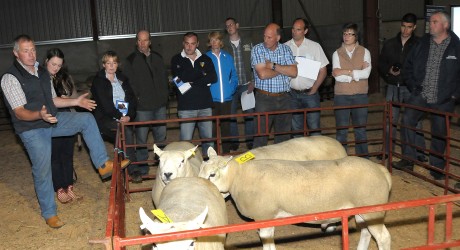KEEPING it simple and knowing which estimated breeding values (EBVs) are key to your sheep system, were just some of the messages that emerged from the first ‘Performance for Profit’ workshop held this week at Logie Durno, Aberdeenshire.
The Logie Durno sheep enterprise, a total of 215 acres, is run by husband and wife, William and Carole Ingram.
Their three children Gregor (24), Bruce (21) and Amy (16) are also heavily involved in producing high index breeding rams.
The climax of their year of hard work and crucial breeding decisions takes place this Wednesday (7th August).
Around 200 recorded rams will be sold at their on farm sale where full EBV information will be available.
The free ‘Performance for Profit’ workshop which focused on the factors affecting profitability of sheep farming and the impact of ram buying decisions on the overall output of flocks, was run by Quality Meat Scotland’s Scottish Sheep Strategy Development Officers, Katie Keiley and Michael Blanche, and attracted more than 30 local sheep farmers.
“Context is important for those considering adopting decision-making tools like EBVs,” said Mr Blanche.
“Firstly, when you separate the subsidy from the sheep and look at net income for upland breeding flocks, it’s a serious eye-opener. It has been difficult to see the financial reward in running a 1,000 ewe enterprise over the last five years. It’s time to change and grasp any method of improvement available to us.
“Secondly, the disparity between the performance of the top third of sheep famers and the bottom third is getting larger in key areas. If you look at the QMS benchmarking results over the last ten years, the difference between these two groups in 2003 in the kg of lamb they produced per ewe was 8kg. By 2012 this had risen to 22kg. The gap has widened by nearly three times.
“There will be many reasons for this but I’m convinced a huge influence has been the greater uptake of EBVs in the top third and the resultant significant genetic effects.”
Mrs Keiley and Mr Blanche explained that EBVs for scan weight, muscle depth, and fat are essential details. Index is a useful overview but should be only treated for the purposes of ranking.
“The prime example of this is fat depth EBV where the index rewards lean, negative fat depth rams,” said Mr Blanche. “If producers are trying to finish lambs straight off grass at 40kg, they really want sires with a slightly positive Fat Depth EBV.
“Once people get the hang of the figures and how they can make them work to suit their system they can be really powerful.
“It’s like the old analogy of looking under the bonnet before you buy the car,” said Mrs Keiley. “But with EBVs you can see the fuel efficiency, acceleration, top speed and even how it will cope with your farm track just from comparing a few numbers.”
Further workshop venues:
Tuesday 27th August 2013, N & G Armstrong, Kirvennie Farm, Wigtown, Wigtownshire, DG8 9DQ
Wednesday 28th August 2013, B Goldie, Townfoot, Mouswald, Dumfriesshire, DG1 4LX
Thursday 29th August 2013, N & D McGowan, Incheoch Farm, Alyth, Blairgowrie, Perthshire, PH11 8HJ
Wednesday 4th September 2013, J Elliot, Roxburgh Mains, Kelso, Roxburghshire, TD5 8NJ
(Plus stand at Kelso Ram Sales, Friday 13th September 2013).
All workshops begin at 7.30pm and there is no need to book a place. For more information, please contact Katie Keiley or Michael Blanche at QMS on 0131 472 4039 or visit the website at www.scottishsheepstrategy.org.uk.
The Logie Durno ram sale on the 7th of August starts at 6pm with viewing from 5pm.
Caption: Willie Ingram talking to some of this week’s workshop participants.
MEDIA RELEASE posted by Quality Meat Scotland. You too can post media releases (aka press releases) on allmediascotland.com. For more information, email here.
Contact: Claire Morrison
Email: cmorrison@qmscotland.co.uk
Website: http://www.qmscotland.co.uk






